Comprehensive Guide to Facebook Ads for Plastic Surgeons: Attract More Patients
Facebook advertising offers plastic surgeons an unparalleled opportunity to target and attract new patients.
With over 2.8 billion users globally and sophisticated targeting options, it’s an excellent platform for reaching people interested in cosmetic surgery services.
In this guide, we’ll cover everything you need to know about Facebook ads for plastic surgeons, from setting up campaigns to optimizing them for better results.
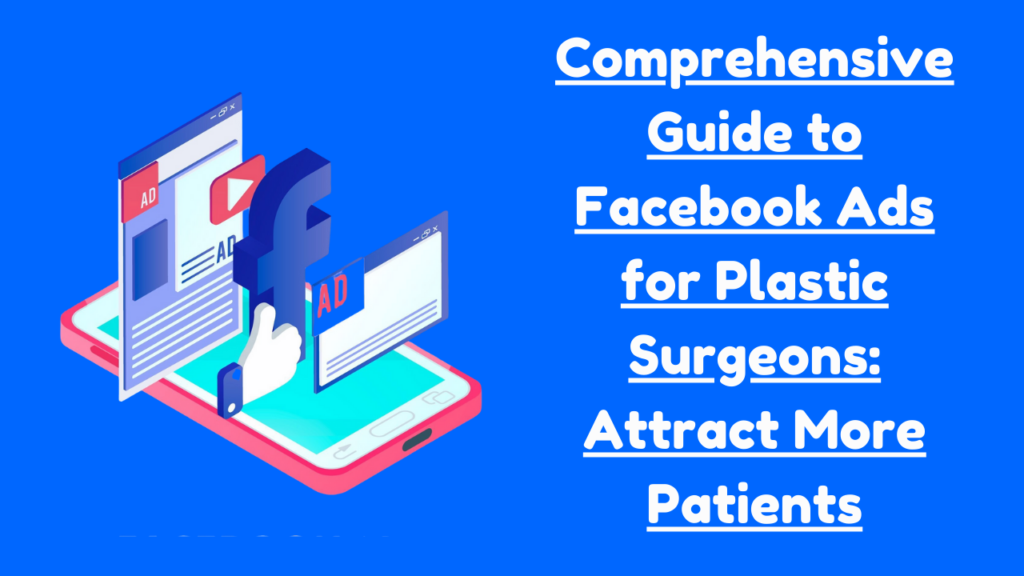
Why Facebook Ads Work for Plastic Surgeons
Plastic surgery is a visual, aspirational field, which makes Facebook’s image- and video-based ads ideal for showcasing your services. Here are the main reasons why Facebook ads are effective for plastic surgeons:
Precision Targeting: You can target specific demographics, interests, locations, and behaviors that match your ideal patient profile.
Visual Appeal: Facebook’s ad formats allow you to use high-quality images and videos, perfect for showcasing before-and-after transformations.
Lead Generation: Facebook ads are highly effective for collecting leads, allowing users to sign up for consultations directly through the platform.
Social Proof: You can leverage patient testimonials, reviews, and real-life stories, which build credibility and trust.
Step 1: Setting Up Your Facebook Ads Account
Before you can start running ads, you’ll need a Facebook Business Manager account. Here’s how to get started:
1. Create a Facebook Business Manager Account:
- Go to business.facebook.com.
- Set up your business by adding your plastic surgery practice’s Facebook page.
- Add any necessary people to manage the ads (such as a marketing team or agency).

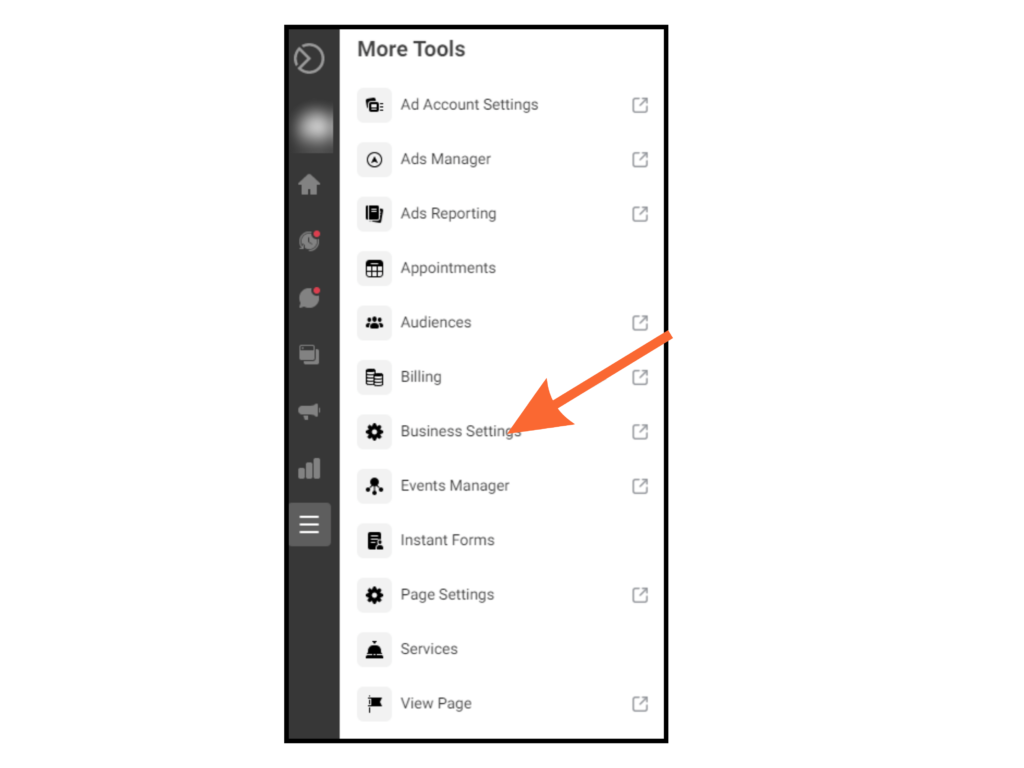
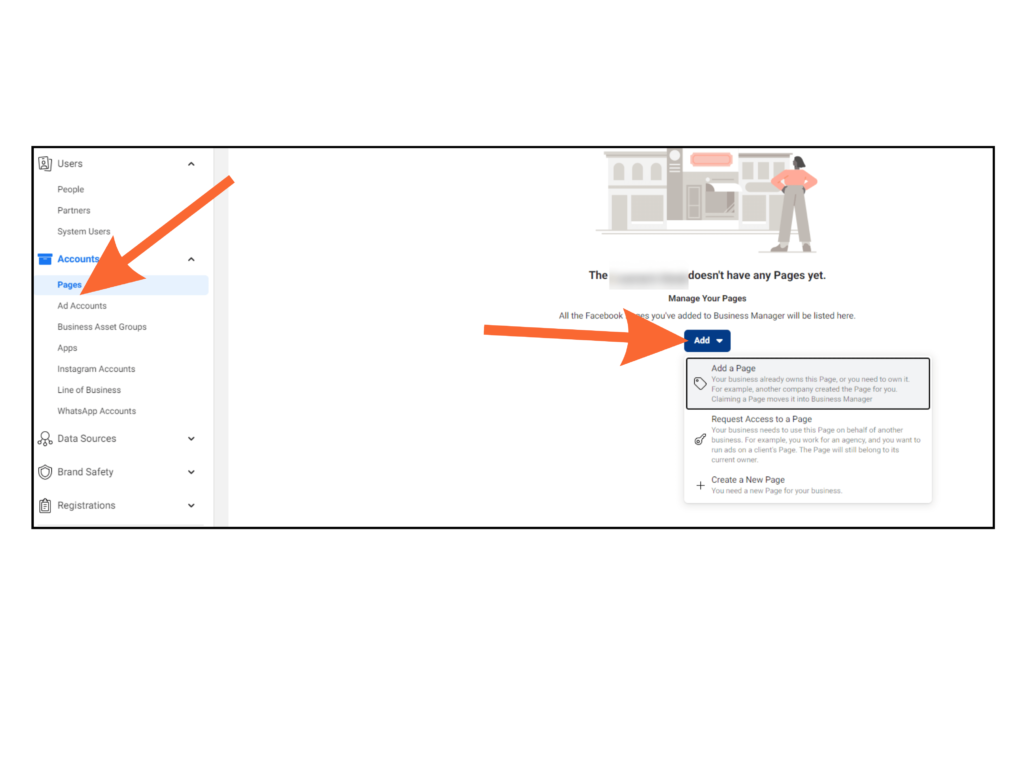


2. Set Up Facebook Pixel:
- Install the Facebook Pixel on your website to track visitor behavior and conversions.
- This tracking tool allows you to retarget users who visit your site and monitor how effective your ads are at generating leads or appointments.
3. Create a Dedicated Landing Page:
- Create a landing page on your website specifically for Facebook ads. Ensure it is conversion-optimized with clear CTAs like “Book a Consultation” or “Get a Free Estimate.”
Step 2: Understanding Your Audience
Facebook allows you to drill down into your ideal patient demographic.
For plastic surgeons, knowing your audience is crucial to ad success. You want to reach people interested in procedures like rhinoplasty, breast augmentation, or liposuction.
Audience Segmentation:
1. Demographics:
Age: Target individuals based on the typical age ranges for certain procedures. For example, you might target 25-45-year-old women for breast augmentation and 35-60-year-olds for facelift procedures.
Gender: Segment by gender depending on the procedure. For example, rhinoplasty and liposuction can be marketed to both men and women, while breast augmentation ads may focus more on women.
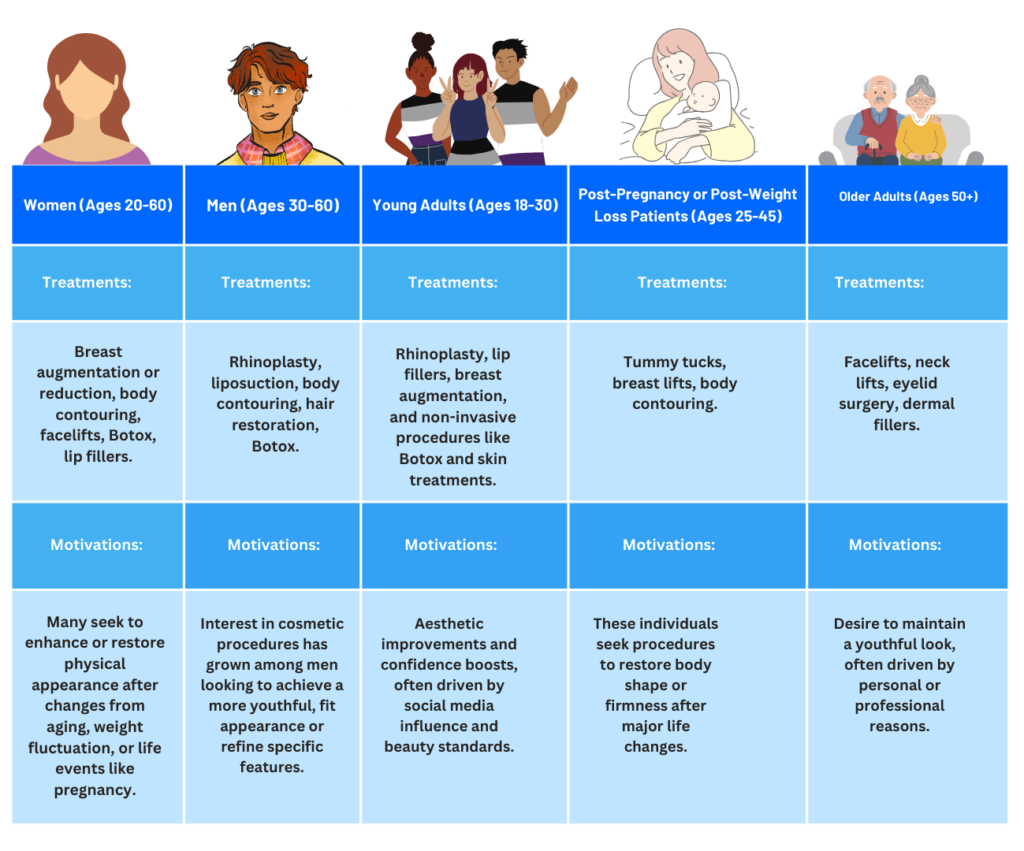
2. Location:
- Use geographic targeting to reach people within your local area. You can set a specific radius around your practice to target individuals nearby.
3. Interests & Behaviors:
- Target people based on interests related to beauty, health, fitness, and cosmetic treatments.
- Focus on those who have engaged with content about plastic surgery, beauty products, or aesthetic treatments.
4. Custom Audiences:
- Website Visitors: Retarget users who have already visited your website but haven’t booked a consultation.
- Lookalike Audiences: Create lookalike audiences based on your current patients or website visitors to expand your reach.
Step 3: Choosing the Right Facebook Ad Format
Facebook offers several ad formats. Choosing the right one depends on the goal of your campaign (brand awareness, lead generation, or patient acquisition).
Here are some ad formats suitable for plastic surgeons:
1. Image Ads:
- Best For: Simple, direct promotions.
- Example: Use before-and-after photos of past patients (with permission) to show the effectiveness of your services.
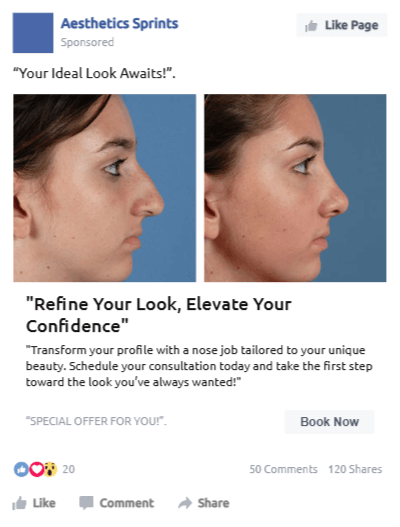
2. Video Ads:
- Best For: Demonstrating procedures or showing behind-the-scenes footage of your practice.
- Example: Create a short 15-30 second video explaining a popular procedure like Botox injections or rhinoplasty. Video ads tend to have higher engagement rates.

3. Carousel Ads:
- Best For: Highlighting multiple services or showing a step-by-step transformation.
- Example: Use a carousel to feature different services such as facelift, liposuction, and tummy tuck, or show multiple angles of a successful patient transformation.

4. Lead Generation Ads:
- Best For: Collecting patient information directly through Facebook.
- Example: Offer a free consultation or downloadable guide (e.g., “Ultimate Guide to Rhinoplasty”) in exchange for a user’s name, email, and phone number.

Step 4: Crafting a Compelling Ad Copy
Your ad copy needs to grab attention, generate interest, and create a desire for your services. For plastic surgeons, patients are often looking for trust, expertise, and a personal connection.
Key Elements of Effective Ad Copy:
Attention-Grabbing Headline:
Example: “Refine your look, Elevate your confidence!”

Speak to Pain Points:
Example:“Struggling with stubborn fat that won’t go away? Liposuction can help you achieve the body you’ve always wanted.”
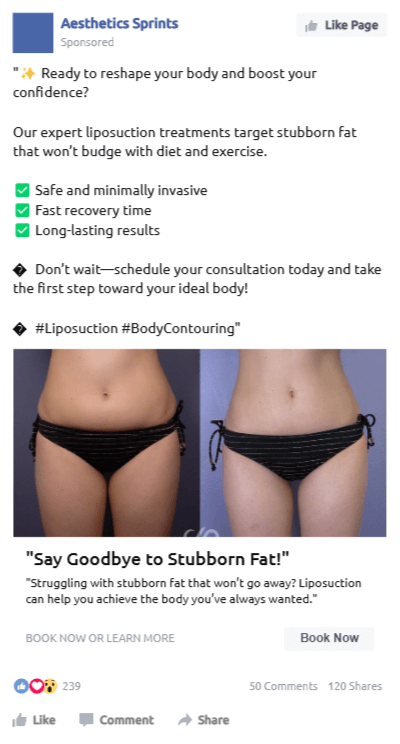
Call to Action (CTA):
Example: “Book a Free Consultation Today” or “See Before & After Photos.”

Social Proof:
Mention patient success stories or high satisfaction rates.
Example: “Join hundreds of satisfied patients who’ve transformed their look with our expert procedures.”

Step 5: Budgeting for Facebook Ads
Plastic surgeons typically have higher customer acquisition costs due to the nature of their services, so it’s important to set a reasonable budget.
Budgeting Tips:
Daily vs. Lifetime Budget: Start with a daily budget to test different ad sets. After seeing what works, switch to a lifetime budget to control costs over the entire duration of the campaign.
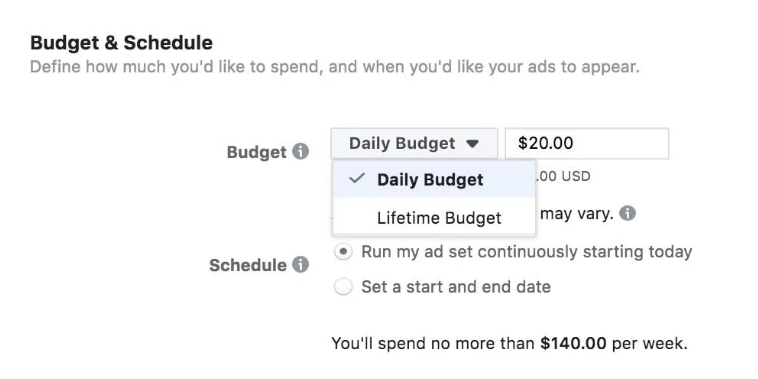
Set Bidding Strategy: Choose “Cost-Per-Result” to control the amount you pay for each lead or consultation.

Allocate Budget to Retargeting: Retargeting people who have visited your website or engaged with your ads but haven’t booked a consultation can be highly effective and cost-efficient.

Step 6: Monitoring and Optimizing Your Facebook Ads
Once your ads are running, it’s important to monitor performance and make adjustments to improve results.
Key Metrics to Track:
Click-Through Rate (CTR): Measures how many people clicked on your ad compared to how many saw it. A low CTR may indicate that your ad isn’t engaging enough.
Cost Per Lead: Keep track of how much you’re paying for each lead or consultation. If this is too high, you may need to tweak your targeting or ad copy.
Conversion Rate: Measure how many people who click your ad end up booking a consultation or taking the desired action.
Frequency: If your ads are being shown to the same people too many times (frequency), it can lead to ad fatigue. Refresh your creative if this happens.
Optimization Tips:
- A/B Testing: Test different images, ad copy, and CTAs to see what resonates best with your audience.
- Refine Targeting: Narrow your audience based on performance. If you’re not getting conversions from a specific group, adjust your targeting parameters.
- Adjust Budget: Increase your budget for high-performing ads and scale down or turn off underperforming ones.
Step 7: Leveraging Patient Testimonials and Reviews
Trust is crucial for plastic surgeons. Patients want to feel comfortable and reassured that they’re in safe hands.
How to Use Reviews in Ads:
- Feature real patient testimonials in your ad copy or videos. This builds credibility and trust.
- Run ads that promote 5-star reviews from platforms like Google or RealSelf to showcase your reputation.
Step 8: Creating a Funnel with Facebook Ads
To convert potential patients, create a marketing funnel with multiple touchpoints:
Top of Funnel (Awareness): Use educational content to introduce your practice and services.
Example: Video ad explaining the benefits of a facelift.

Middle of Funnel (Consideration): Retarget people who engaged with your awareness ads. Offer more detailed information or testimonials.
Example: Carousel ad showcasing before-and-after photos with patient testimonials.
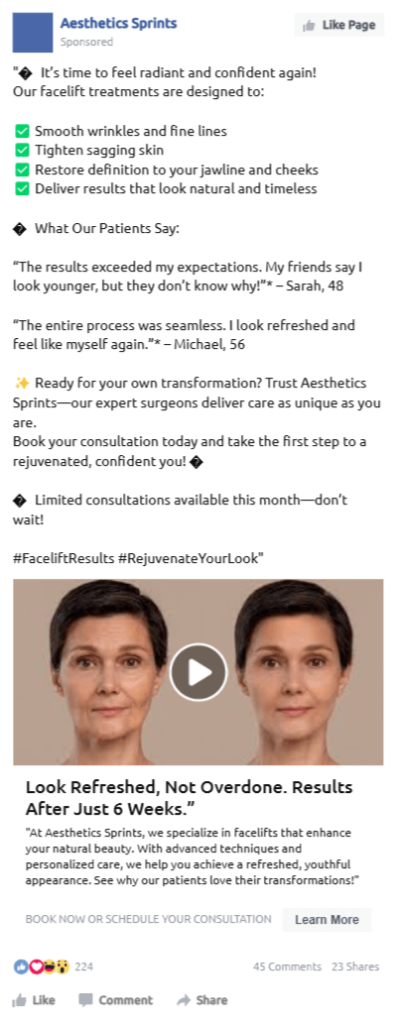
Bottom of Funnel (Decision): Target warm leads who have visited your website but haven’t booked a consultation. Use a strong CTA.
Example: Lead ad offering a free consultation for people considering facelift.

Conclusion
Facebook ads are an invaluable tool for plastic surgeons to grow their practice, attract new patients, and build a strong online presence.
By targeting the right audience, using engaging visuals and compelling copy, and optimizing your campaigns regularly, you can drive consistent leads and bookings.
Remember, digital marketing is a long-term strategy, and continuously refining your approach will yield better results over time.
Take the leap and leverage the power of Facebook ads to expand your plastic surgery practice and help more patients achieve their aesthetic goals!

About the Author: Jatin Thakur
Jatin Thakur, founder of Aesthetics Sprints, is a seasoned digital marketer with 8+ years of experience helping plastic surgeons attract patients and grow their practices. Specializing in Local SEO, PPC Ads, and Social media marketing strategy, Jatin empowers aesthetic professionals to thrive in a competitive market.
FAQs on Plastic Surgery and Facebook Ads
1. Is $1000 enough for Facebook ads?
2. Who is the target audience for plastic surgery?
3. Can you advertise plastic surgery?
4. What is forbidden to advertise on Facebook?
5. Does Facebook allow Botox ads?
"Ready to Attract More Patients to Your Practice?"
Grow your practice with tailored marketing that attracts and converts the right patients. From building your online presence to crafting high-converting campaigns, we specialize in driving real results for plastic surgeons.



